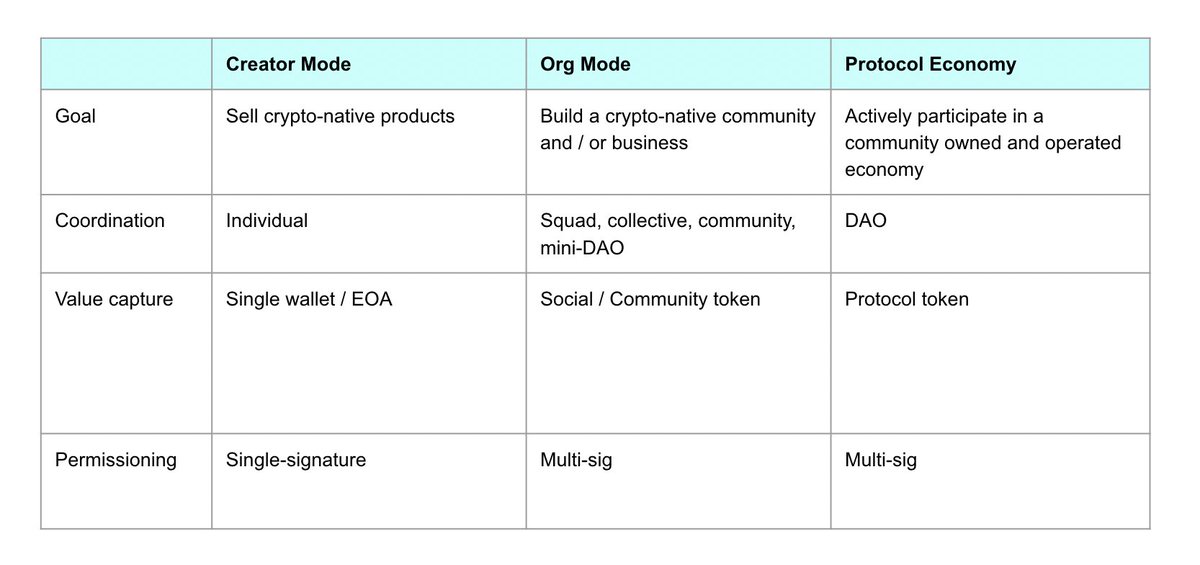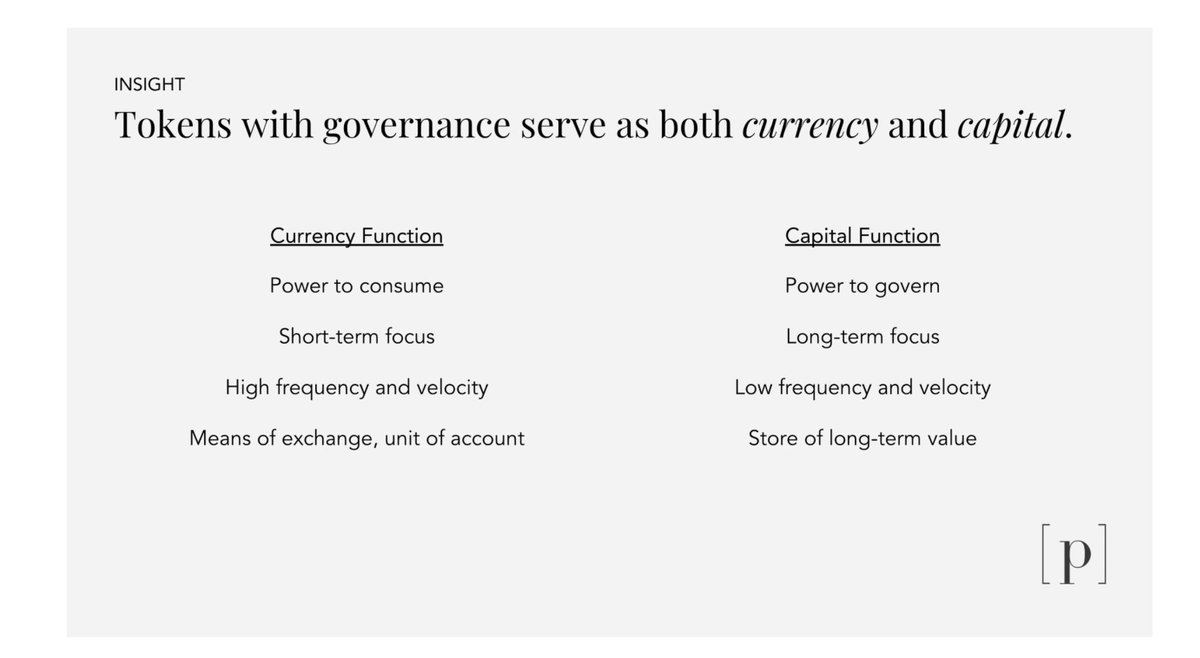we& #39;ve spent a lot of time thinking about our near and long-term strategy at @viamirror recently
cool thing about crypto is that a lot of these playbooks haven& #39;t been written yet
here& #39;s how we think about building creator-focused protocols https://p.mirror.xyz/1EpvJwUpx_KlRcHOKLNqADEkwHL_Z1ZYKobF2uLwgBg">https://p.mirror.xyz/1EpvJwUpx...
cool thing about crypto is that a lot of these playbooks haven& #39;t been written yet
here& #39;s how we think about building creator-focused protocols https://p.mirror.xyz/1EpvJwUpx_KlRcHOKLNqADEkwHL_Z1ZYKobF2uLwgBg">https://p.mirror.xyz/1EpvJwUpx...
"come for the tool stay for the network" is a classic strategy for bootstrapping social networks
it aimed to solve a hard problem: how do you convince people to join your social network when there& #39;s nobody else to socialize with?
it aimed to solve a hard problem: how do you convince people to join your social network when there& #39;s nobody else to socialize with?
the strategy was to build a single player tool w/ utility and then add social features (follows, likes, comments, etc.)
but w/ creator-focused platforms, "come for the tool, stay for the network" is now "come for the creator, stay for the network" https://twitter.com/ljin18/status/1195412859733168128">https://twitter.com/ljin18/st...
but w/ creator-focused platforms, "come for the tool, stay for the network" is now "come for the creator, stay for the network" https://twitter.com/ljin18/status/1195412859733168128">https://twitter.com/ljin18/st...
creator-focused platforms realize that wherever the creator goes, the audience and attention follows. therefore, platforms strengthen their network by attracting top creators
IG, TikTok, Snap, Spotify, Substack, and Triller (lol) all have creator funds that use this approach
IG, TikTok, Snap, Spotify, Substack, and Triller (lol) all have creator funds that use this approach
but there& #39;s a few issues with this model:
- it& #39;s hard to make a sustainable living unless you& #39;re a top creator
- creator payouts are determined by opaque processes
- content and social graphs are rarely portable across platforms
- it& #39;s hard to make a sustainable living unless you& #39;re a top creator
- creator payouts are determined by opaque processes
- content and social graphs are rarely portable across platforms
at @viamirror, we& #39;re thinking about ways to put more power back in the hands of creators and their audiences
but we aren& #39;t a "company", in the traditional sense. instead, we& #39;re building a creator-focused protocol.
but we aren& #39;t a "company", in the traditional sense. instead, we& #39;re building a creator-focused protocol.
we work w/ creators to understand their needs, write smart contracts, deploy them to the Ethereum network, create interfaces to access these smart contracts, and have the goal of developing a new type of network for creators and their audiences
decentralized protocols aren& #39;t social networks. they& #39;re cryptoeconomic networks
instead of "come for the creator, stay for the network", I think the mantra of creator-focused protocols will be more like "come for the creator, stay for the economy."
here& #39;s the difference
instead of "come for the creator, stay for the network", I think the mantra of creator-focused protocols will be more like "come for the creator, stay for the economy."
here& #39;s the difference
a social network is:
- owned by shareholders (mainly finance firms, execs, board, early employees)
- governed by shareholders (board, CEO, sometimes activist hedge funds)
- most code is private
- data is secured by the company& #39;s eng team
- network becomes global over time
- owned by shareholders (mainly finance firms, execs, board, early employees)
- governed by shareholders (board, CEO, sometimes activist hedge funds)
- most code is private
- data is secured by the company& #39;s eng team
- network becomes global over time
a cryptoeconomic network is:
- owned by the community (through a protocol token)
- governed by the community
- open source
- secured through distributed consensus, cryptography, and public / private key pairs
- global from day one
- owned by the community (through a protocol token)
- governed by the community
- open source
- secured through distributed consensus, cryptography, and public / private key pairs
- global from day one
creator-focused protocols will be more like internet-native economies than traditional social networks.
they& #39;ll have:
- community-led committees
- native protocol tokens for governance, value capture, and utility
- decentralized grant programs
- an open developer ecosystem
they& #39;ll have:
- community-led committees
- native protocol tokens for governance, value capture, and utility
- decentralized grant programs
- an open developer ecosystem
a few years ago, this sounded crazy
but since 2018, DeFi protocols like Uniswap, Compound, and AAVE have earned billion dollar treasuries, launched protocol tokens, and started experimenting with community-led initiatives like grant programs https://twitter.com/HelloShreyas/status/1382751724784390146">https://twitter.com/HelloShre...
but since 2018, DeFi protocols like Uniswap, Compound, and AAVE have earned billion dollar treasuries, launched protocol tokens, and started experimenting with community-led initiatives like grant programs https://twitter.com/HelloShreyas/status/1382751724784390146">https://twitter.com/HelloShre...
over the next few years, I think creator-focused protocols will reach a similar scale
I believe successful creator-focused protocols will go through three phases:
1/ Creator Mode
2/ Org. Mode
3/ A Protocol Economy
I believe successful creator-focused protocols will go through three phases:
1/ Creator Mode
2/ Org. Mode
3/ A Protocol Economy
1/ Creator Mode
goal: help creators generate on-chain revenue by selling crypto-native products
this is a good first step bc:
- convinces creators that it& #39;s worth spending more time using crypto protocols
- gets a creator& #39;s audience to on-ramp to ETH
- helps future experiments
goal: help creators generate on-chain revenue by selling crypto-native products
this is a good first step bc:
- convinces creators that it& #39;s worth spending more time using crypto protocols
- gets a creator& #39;s audience to on-ramp to ETH
- helps future experiments
in terms of deciding what to build, I like @ljin18 & #39;s framework for creator lifecycles.
there are four stages:
1. create something
2. build audience
3. monetize
4. manage and grow business
there are four stages:
1. create something
2. build audience
3. monetize
4. manage and grow business
as a creator-focused protocol, monetizing NFTs is a safe bet given all the interest, activity, and novel use cases
at @viamirror, we& #39;ve built smart contracts to help w funding and monetization:
- tokenized crowdfunds
- reserve auctions for zNFTs (h/ t @ourZORA)
- revenue splits
at @viamirror, we& #39;ve built smart contracts to help w funding and monetization:
- tokenized crowdfunds
- reserve auctions for zNFTs (h/ t @ourZORA)
- revenue splits
we& #39;ve also built a crypto-native publishing stack to help w/ content creation:
- decentralized identity w/ ENS (kinda like a Cash App handle + Twitter username)
- decentralized storage w/ Arweave
here& #39;s a few things we& #39;ve learned from building a creator-focused protocol so far
- decentralized identity w/ ENS (kinda like a Cash App handle + Twitter username)
- decentralized storage w/ Arweave
here& #39;s a few things we& #39;ve learned from building a creator-focused protocol so far
- launch features with a specific use case in mind and then generalize it
- optimize smart contracts for security, mechanism design, composability, and gas efficiency
- use guarded launches w/ funding caps to limit downside risk
- optimize smart contracts for security, mechanism design, composability, and gas efficiency
- use guarded launches w/ funding caps to limit downside risk
one of the most common pieces of feedback we& #39;ve received is that creators want to build sustainable recurring-revenue businesses using crypto-native tools
over the past few years, protocols have iterated on Creator Mode. I think the next couple years will be about Org. Mode
over the past few years, protocols have iterated on Creator Mode. I think the next couple years will be about Org. Mode
2/ Org. Mode
goal: help creators and communities build sustainable crypto-native businesses
Creator Mode is like being an independent artist while Org. Mode is like being signed to a record label
h/t @Iiterature @jarroddicker
goal: help creators and communities build sustainable crypto-native businesses
Creator Mode is like being an independent artist while Org. Mode is like being signed to a record label
h/t @Iiterature @jarroddicker
in Org Mode, instead of value flowing to a single wallet, value flows to an ERC20 token
here& #39;s how it could work:
- issue an ERC20 token (crowdsale, airdrop, mine)
- develop on-chain revenue streams
- funnel revenue to a treasury contract
- redistribute funds through governance
here& #39;s how it could work:
- issue an ERC20 token (crowdsale, airdrop, mine)
- develop on-chain revenue streams
- funnel revenue to a treasury contract
- redistribute funds through governance
there& #39;s a ton of tooling to be built for Org. Mode
traditional stack:
- financing
- payment processing
- monetization
- marketing automation
- product analytics
plus, web3 stack
- multi-sig capabilities
- on-chain analytics
- governance
- treasury mgmt
- token rewards programs
traditional stack:
- financing
- payment processing
- monetization
- marketing automation
- product analytics
plus, web3 stack
- multi-sig capabilities
- on-chain analytics
- governance
- treasury mgmt
- token rewards programs
at @viamirror, we think it& #39;s useful to hone in a specific use case, provide the tooling it needs to be successful, and expand from there.
some options:
- publication DAO
- investment clubs
- decentralized grant programs
- social games for curators / collectors
some options:
- publication DAO
- investment clubs
- decentralized grant programs
- social games for curators / collectors
as your protocol builds tools to help creators / communities start, manage, and scale crypto-native businesses, it becomes time to think about how to decentralize the protocol itself.
this brings us to the final phase: A Protocol Economy
this brings us to the final phase: A Protocol Economy
3/ A Protocol Economy
Goal: Build a community owned / operated protocol with minimal involvement from the initial development team. Ongoing development is driven by community-led committees with active participation from creators, curators, collectors, and a developer ecosystem.
Goal: Build a community owned / operated protocol with minimal involvement from the initial development team. Ongoing development is driven by community-led committees with active participation from creators, curators, collectors, and a developer ecosystem.
over the past few months, DeFi protocols have started entering this phase. they& #39;re managing billion dollar treasuries, tokens with billion dollar market caps, and coordinating hundreds of people without any formal top-down structure
it& #39;s pretty mindblowing
it& #39;s pretty mindblowing
we& #39;re still learning about best practices in the protocol economy phase but here are a few key components:
- a protocol token. your token can be used as currency OR capital.
h/t @jmonegro
- a protocol token. your token can be used as currency OR capital.
h/t @jmonegro
- third party developer ecosystem. requires a suite of tools like audited / well-tested smart contracts, documentation, subgraphs for querying on-chain data, SDKs, grants, and bug bounties
over time, the best protocols will have tens or hundreds of apps integrating w/ them
over time, the best protocols will have tens or hundreds of apps integrating w/ them
- community-led committees. focused on managing product roadmap, budgets, monetary policy, long-term strategy, etc.
- community benefit programs. could include universal creator income, insurance for smart contracts, p2p zero-interest loans, pooled savings account, etc
- community benefit programs. could include universal creator income, insurance for smart contracts, p2p zero-interest loans, pooled savings account, etc
just how we saw a few DeFi protocols scale over the past few years, I think we& #39;ll see the same w/ creator-focused protocols soon
they& #39;ll go from Creator Mode -> Org Mode -> A Protocol Economy
come for the creator, stay for the economy
they& #39;ll go from Creator Mode -> Org Mode -> A Protocol Economy
come for the creator, stay for the economy
here& #39;s a more detailed version https://p.mirror.xyz/1EpvJwUpx_KlRcHOKLNqADEkwHL_Z1ZYKobF2uLwgBg">https://p.mirror.xyz/1EpvJwUpx...

 Read on Twitter
Read on Twitter




